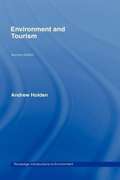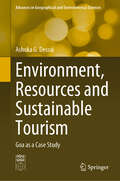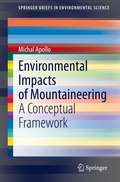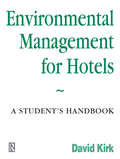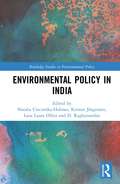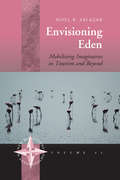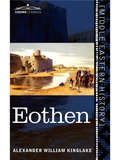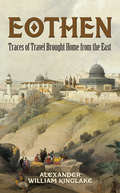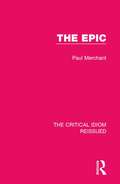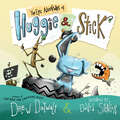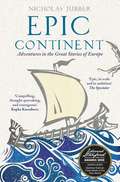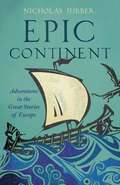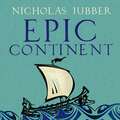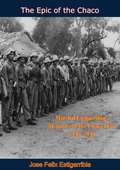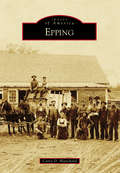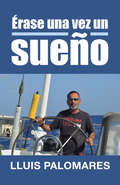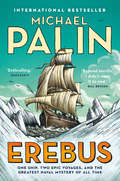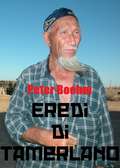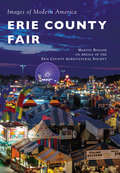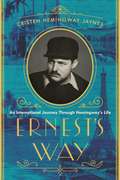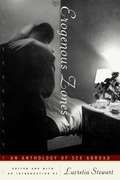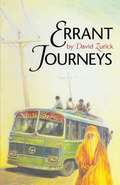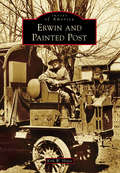- Table View
- List View
Environment and Tourism (2nd Edition)
by Andrew HoldenThis second edition of Environment and Tourism reflects changes in the relationship between tourism, society and the natural environment in the first decade of the new century. Alongside the updating of all statistics, environmental policy initiatives, examples and case studies new material has been added. This includes two new chapters: one on climate change and natural disasters and the other on the relationship between tourism and poverty. These themes have direct relevance, not only to tourism, but are reflective of the wider relationship between nature and society, a thesis that contextualizes this book. Tourism is also analyzed as an interconnected system, linking the environments of where tourists come from, with the ones they go to. Taking a holistic view of the tourism system and how it interacts with the natural environment, this volume illustrates the positive and negative effects of this relationship, and importantly how tourism can be planned and managed to encourage natural resource conservation and aid human development. It is an invaluable tool for all those studying human geography, tourism and environment studies.
Environment, Resources and Sustainable Tourism: Goa as a Case Study (Advances in Geographical and Environmental Sciences)
by Ashoka G. DessaiThis book suggests sustainable economy from the viewpoint of tourism fostering low carbon footprint. Focussed on conserving heritage, culture and endemic biota of a crucial biodiversity hotspot of the world, the book discusses the impact of a large population, fast-paced development and excessive consumption of earth resources by tourism in a developing economy. The book (i) assesses the impact of overexploitation of earth resources on environmental components such as air, water, land and people, (ii) examines the sustainability of tourism on the physical, economic and socio-cultural environment including human lifestyles, (iii) presents the potential of tourism in promoting sustainable development, poverty alleviation and conservation of nature and (iv) formulates recommendations for tourism, fostering sustainable development in Goa, India. The book offers students, researchers, academics and professionals a comprehensive discourse integrating geological and societal perspectives on core issues. It generates critical thinking on the complex issue of sustainable tourism by providing in-depth perspective on peoples of different hues and their role in safeguarding the future of this unique region.
Environmental Impacts of Mountaineering: A Conceptual Framework (SpringerBriefs in Environmental Science)
by Michal ApolloThis book investigates the consequences of mountaineering (hiking, trekking, climbing) on the natural environment. These consequences are divided into three groups: 1) transformations caused by the mountaineer’s, or other people’s, stay in a mountaineering region; 2) transformations caused by the mountaineer’s travel (movement) through a mountaineering region, with the consideration of the ground type (rock, rock and grass, grass, residual soil, snow, ice), and 3) transformations caused by the use of mountaineering equipment. Each of the three groups are examined individually for their direct interference with the environment, i.e. caused by the main activities of climbing, trekking and hiking (both for elite and mass mountaineering) and their indirect interference caused by auxiliary activity (mainly in the case of mass mountaineering). Auxiliary activity includes guide services, transport of equipment, use of base camp facilities and the delivery of artificial support equipment, and supports the main activity. The consequences of mountaineering on the natural environment are characterized in terms of individual components of the environment (land relief, soil, vegetation, fauna, and landscape) and location/zone of mountaineering activity (hiking, trekking or climbing zone). Because of the connections and interdependence between particular components of the environment (biotic and abiotic), only preservation of each of them can bring the desired effect – a reduction in the negative impact of mountaineering. This book presents comprehensive research outcomes and serves as a platform for more detailed, future studies.
Environmental Management for Hotels
by David KirkEnvironmental Management for Hotels is a textbook for hospitality students that covers the relatively new field of environmental management. The reader is guided in how to make decisions which allow hotels to obtain optimum benefits for the environment whilst not threatening their own financial viability. Students are given an understanding of both the concepts and practical implications of environmental challenges relating to hotels. The case study material incorporated ties in theory with real life, and provides an international context. The text emphasizes supervisory issues which relate to the management of hospitality operations in ways which are sensitive to the impact on the environment. The main areas of environmental management featured are: *water *energy *the indoor environment *materials and waste.
Environmental Policy in India (Routledge Studies in Environmental Policy)
by Natalia Ciecierska-Holmes Kirsten Jörgensen Lana Laura Ollier D. RaghunandanThis book systematically introduces historical trajectories and dynamics of environmental policy and governance in India. Following the features of environmental policy in India as outlined in Chapter 1, subsequent chapters explore domestic and international factors that shape environmental policy in the country. The chapters examine the interplay between governmental and non-governmental actors, and the influence of social mobilisation and institutions on environmental policy and governance. Analysing various policy trajectories, the chapters identify and explore five central environmental policy subsystems: forests, water, climate, energy and city development. The authors drill down into the social, economic, political and ecological dimensions of each system, shedding light on why striking a balance between national economic growth and environmental sustainability is so challenging. Drawing on political science theories of policy processes and related theoretical concepts, this innovative edited volume will be of great interest to students and scholars of environmental policy and politics and South Asian studies more broadly.
Envisioning Eden: Mobilizing Imaginaries in Tourism and Beyond (New Directions in Anthropology #31)
by Noel B. SalazarAs tourism service standards become more homogeneous, travel destinations worldwide are conforming yet still trying to maintain, or even increase, their distinctiveness. Based on more than two years of fieldwork in Yogyakarta, Indonesia and Arusha, Tanzania, this book offers an in-depth investigation of the local-to-global dynamics of contemporary tourism. Each destination offers examples that illustrate how tour guide narratives and practices are informed by widely circulating imaginaries of the past as well as personal imaginings of the future.
Envisioning New Jersey: An Illustrated History of the Garden State
by Richard F. Veit Maxine N. LurieSee New Jersey history as you read about it! Envisioning New Jersey brings together 650 spectacular images that illuminate the course of the state's history, from prehistoric times to the present. Readers may think they know New Jersey's history--the state's increasing diversity, industrialization, and suburbanization--but the visual record presented here dramatically deepens and enriches that knowledge. Maxine N. Lurie and Richard F. Veit, two leading authorities on New Jersey history, present a smorgasbord of informative pictures, ranging from paintings and photographs to documents and maps. Portraits of George Washington and Molly Pitcher from the Revolution, battle flags from the War of 1812 and the Civil War, women air raid wardens patrolling the streets of Newark during World War II, the Vietnam War Memorial--all show New Jerseyans fighting for liberty. There are also pictures of Thomas Mundy Peterson, the first African American to vote after passage of the Fifteenth Amendment; Paul Robeson marching for civil rights; university students protesting in the 1960s; and Martin Luther King speaking at Monmouth University. The authors highlight the ethnic and religious variety of New Jersey inhabitants with images that range from Native American arrowheads and fishing implements, to Dutch and German buildings, early African American churches and leaders, and modern Catholic and Hindu houses of worship. Here, too, are the great New Jersey innovators from Thomas Edison to the Bell Labs scientists who worked on transistors. Compiled by the authors of New Jersey: A History of the Garden State, this volume is intended as an illustrated companion to that earlier volume. Envisioning New Jersey also stands on its own because essays synthesizing each era accompany the illustrations. A fascinating gold mine of images from the state's past, Envisioning New Jersey is the first illustrated book on the Garden State that covers its complete history, capturing the amazing transformation of New Jersey over time.View sample pages (http://issuu.com/rutgersuniversitypress/docs/lurie_veit_envisioning_sample)Thanks to the New Jersey Historical Commission, the New Jersey Council for the Humanities, and generous individual donors for making this project possible.
EOTHEN: Traces of Travel Brought Home from the East
by Alexander William KinglakeThis is an extraordinary work of travel writing that is more about the author's personal exploration than it is about monuments and museums. Inspired by a journey with an Eton colleague ten years prior, this memoir exemplifies how travel can become a personal experience and change who we are. Though over a century and half old, Eothen, Traces of Travel Brought Home from the East feels as strikingly modern as any contemporary literary memoir. Kinglake's intimate, conversational style and his sense of humor and irony made Eothen-meaning "from the early dawn" or "from the East"-an instant success when it was first published in 1844. Even today, in the 21st century, it maintains its fresh and original feel. For lovers of travel, the Middle East, or self discovery this book will become an instant favorite.
Eothen: Traces of Travel Brought Home from the East
by Alexander William Kinglake"My favorite travel book. Sparkling, ironic, and terrific fun." -- Jan MorrisEothen ("From the East") recaptures a bold young Englishman's exploits in the Middle East during the 1830s. Alexander William Kinglake recounts his rambles through the Balkans, Turkey, Cyprus, Syria, Palestine, and Egypt in a style radically different from other travel books of his era. Rather than dwelling on art or monuments, Kinglake's captivating narrative focuses on the natives and their cities. His adventures - populated by Bedouins, pashas, slave-traders, monks, pilgrims, and other colorfully drawn personalities - include crossing the desolate Sinai with a four-camel caravan and a sojourn in plague-ridden Cairo. A contemporary of Gladstone at Eton and of Tennyson and Thackeray at Cambridge, Kinglake offers a frankly imperialistic worldview. "As I felt so have I written," he declares in his preface, and his forthright expressions of his thoughts and impressions range in mood from confessional, to comic, to serious, to romantic. Victorian readers were captivated by Kinglake's chatty tone and his uncompromising honesty, and two centuries later this remarkable travelogue remains funny, fresh, and original.
The Epic (The Critical Idiom Reissued #16)
by Paul MerchantFirst published in 1971, this work examines the tradition of the epic and the many forms in which it has presented itself over time. After unpicking the defining aspects of an epic, the book tracks the literary tradition from the classical period through to modern day. Exploring major texts such as Beowulf, Odyssey, Divina Comedia, The Faerie Queene and Ulysses, this work will be a valuable resource for those studying the epic and English literature.
The Epic Adventures of Huggie & Stick
by Drew Daywalt* "A surefire read-aloud for any wannabe hero." --Booklist (starred review)From Drew Daywalt, the #1 New York Times bestselling author of The Day the Crayons Quit, comes a hilarious buddy-comedy picture book starring a grouchy stuffed bunny and a happy-go-lucky stick.When super cheerful Stick and grumpy stuffed bunny Huggie get thrown from a backpack, the adventure is on! Together this odd couple survives encounters with sea-faring pirates, raging rhinos in Africa, sword-wielding royalty in Europe, stick-eating panda bears in Asia, sharks in Australia, hungry penguins in Antarctica, and piranhas in South America--all before finally making it home to North America. A fantastically funny read-aloud about two unlikely friends and their epic journey around the world.
Epic Continent: Adventures in the Great Stories of Europe
by Nicholas JubberThese are the stories that made Europe.Journeying from Turkey to Iceland, award-winning travel writer Nicholas Jubber takes us on a fascinating adventure through our continent's most enduring epic poems to learn how they were shaped by their times, and how they have since shaped us. The great European epics were all inspired by moments of seismic change: The Odyssey tells of the aftermath of the Trojan War, the primal conflict from which much of European civilisation was spawned. The Song of the Nibelungen tracks the collapse of a Germanic kingdom on the edge of the Roman Empire. Both the French Song of Roland and the Serbian Kosovo Cycle emerged from devastating conflicts between Christian and Muslim powers. Beowulf, the only surviving Old English epic, and the great Icelandic Saga of Burnt Njal, respond to times of great religious struggle - the shift from paganism to Christianity. These stories have stirred passions ever since they were composed, motivating armies and revolutionaries, and they continue to do so today.Reaching back into the ancient and medieval eras in which these defining works were produced, and investigating their continuing influence today, Epic Continent explores how matters of honour, fundamentalism, fate, nationhood, sex, class and politics have preoccupied the people of Europe across the millennia. In these tales soaked in blood and fire, Nicholas Jubber discovers how the world of gods and emperors, dragons and water-maidens, knights and princesses made our own: their deep impact on European identity, and their resonance in our turbulent times.
Epic Continent: Adventures in the Great Stories of Europe
by Nicholas Jubber'The prose is colourful and vigorous ... Jubber's journeying has indeed been epic, in scale and in ambition. In this thoughtful travelogue he has woven together colourful ancient and modern threads into a European tapestry that combines the sombre and the sparkling' Spectator'A genuine epic' WanderlustAward-winning travel writer Nicholas Jubber journeys across Europe exploring Europe's epic poems, from the Odyssey to Beowulf, the Song of Roland to theNibelungenlied, and their impact on European identity in these turbulent times.These are the stories that made Europe.Journeying from Turkey to Iceland, award-winning travel writer Nicholas Jubber takes us on a fascinating adventure through our continent's most enduring epic poems to learn how they were shaped by their times, and how they have since shaped us.The great European epics were all inspired by moments of seismic change: The Odyssey tells of the aftermath of the Trojan War, the primal conflict from which much of European civilisation was spawned. The Song of the Nibelungen tracks the collapse of a Germanic kingdom on the edge of the Roman Empire. Both the French Song of Roland and the Serbian Kosovo Cycleemerged from devastating conflicts between Christian and Muslim powers. Beowulf, the only surviving Old English epic, and the great Icelandic Saga of Burnt Njal, respond to times of great religious struggle - the shift from paganism to Christianity. These stories have stirred passions ever since they were composed, motivating armies and revolutionaries, and they continue to do so today.Reaching back into the ancient and medieval eras in which these defining works were produced, and investigating their continuing influence today, Epic Continent explores how matters of honour, fundamentalism, fate, nationhood, sex, class and politics have preoccupied the people of Europe across the millennia. In these tales soaked in blood and fire, Nicholas Jubber discovers how the world of gods and emperors, dragons and water-maidens, knights and princesses made our own: their deep impact on European identity, and their resonance in our turbulent times.
Epic Continent: Adventures in the Great Stories of Europe
by Nicholas JubberShortlisted for the Stanford Dolman Travel Book of the Year 2020Award-winning travel writer Nicholas Jubber journeys across Europe exploring Europe's epic poems, from the Odyssey to Beowulf, the Song of Roland to the Nibelungenlied, and their impact on European identity in these turbulent times. These are the stories that made Europe.Journeying from Turkey to Iceland, award-winning travel writer Nicholas Jubber takes us on a fascinating adventure through our continent's most enduring epic poems to learn how they were shaped by their times, and how they have since shaped us. The great European epics were all inspired by moments of seismic change: The Odyssey tells of the aftermath of the Trojan War, the primal conflict from which much of European civilisation was spawned. The Song of the Nibelungen tracks the collapse of a Germanic kingdom on the edge of the Roman Empire. Both the French Song of Roland and the Serbian Kosovo Cycle emerged from devastating conflicts between Christian and Muslim powers. Beowulf, the only surviving Old English epic, and the great Icelandic Saga of Burnt Njal, respond to times of great religious struggle - the shift from paganism to Christianity. These stories have stirred passions ever since they were composed, motivating armies and revolutionaries, and they continue to do so today.Reaching back into the ancient and medieval eras in which these defining works were produced, and investigating their continuing influence today, Epic Continent explores how matters of honour, fundamentalism, fate, nationhood, sex, class and politics have preoccupied the people of Europe across the millennia. In these tales soaked in blood and fire, Nicholas Jubber discovers how the world of gods and emperors, dragons and water-maidens, knights and princesses made our own: their deep impact on European identity, and their resonance in our turbulent times.(P)2019 Hodder & Stoughton Limited
The Epic of the Chaco: Marshal Estigarribia’s Memoirs of the Chaco War, 1932-1935
by Jose Felix EstigarribiaOriginally published in 1950, The Epic of the Chaco is the fascinating memoir of the 34th President of Paraguay, Jose Felix Estigarribia, written between 1938-1939 in Washington, D.C., “whilst discharging his duties as envoy extraordinary and minister plenipotentiary Paraguay.” The book’s editor, Pablo Max Ynsfrán, acted as counsellor of the Paraguayan legation during the same period and collaborated in drafting Estigarribia’s recollections as they are set down in the present volume.“The importance of this publication for the military historian of the Chaco War (1932-1935), in which Paraguay and Bolivia were involved, can hardly be overrated. Marshal Estigarribia held in that armed conflict—one of the most sanguinary ever fought by two South-American republics—the unique position of being the top planner (perhaps the only one) and the commander in chief of the Paraguayan army in the field during the entire course of the campaign. The remarkable success of his leadership is a well-known fact. He emerged from the Chaco War as one of the outstanding masters of strategy in South-American history.”—Editor’s Preface
Epping (Images of America)
by Corey BlanchardWith its lush forests, fertile land, and abundant waterways, Epping began attracting European settlers as early as 1710 before incorporating as an independent town in 1741. The town became home to successful farms, lumber operations, and mills built along the Lamprey River. Clay that lay beneath the fertile soil emerged as an important resource when commercial brickyards began popping up all over town in 1822. Epping became a crossroads for multiple rail lines, which spurred economic development and population booms. In 1862, undeveloped land became home to the Methodist campground Camp Hedding. Factories, especially those specializing in shoes, were established in the area as well. Epping's industrial concerns lasted until the late 20th century, when it grew as a retail center at the junction of Routes 101 and 125. Epping has been home to prominent residents, including a Revolutionary War general, three New Hampshire governors, a world heavyweight boxing champion, the first person to circumnavigate the world on a motorcycle, and a female collegiate basketball great.
Érase una vez un sueño
by Lluis PalomaresNo ha sido fácil, pero lo hemos conseguido, hemos cruzado el atlántico a vela. <P><P> Esta es la historia de un sueño hecho realidad de un grupo de amigos amantes del mar que querían cruzar el Atlántico a vela. <P>El autor narra en un lenguaje llano y ameno todo lo que ocurrió desde el día que decidieron hacer realidad su sueño, hasta que regresaron a casa después de haberlo conseguido.
Erebus: One Ship, Two Epic Voyages, and the Greatest Naval Mystery of All Time
by Michael PalinIntrepid voyager, writer and comedian Michael Palin follows the trail of two expeditions made by the Royal Navy's HMS Erebus to opposite ends of the globe, reliving the voyages and investigating the ship itself, lost on the final Franklin expedition and discovered with the help of Inuit knowledge in 2014.The story of a ship begins after the defeat of Napoleon at Waterloo, when Great Britain had more bomb ships than it had enemies. The solid, reinforced hulls of HMS Erebus, and another bomb ship, HMS Terror, made them suitable for discovering what lay at the coldest ends of the earth. In 1839, Erebus was chosen as the flagship of an expedition to penetrate south to explore Antarctica. Under the leadership of the charismatic James Clark Ross, she and HMS Terror sailed further south than anyone had been before. But Antarctica never captured the national imagination; what the British navy needed now was confirmation of its superiority by making the discovery, once and for all, of a route through the North-West Passage. Chosen to lead the mission was Sir John Franklin, at 59 someone many considered too old for such a hazardous journey. Nevertheless, he and his men confidently sailed away down the Thames in April 1845. Provisioned for three winters in the Arctic, Erebus and Terror and the 129 men of the Franklin expedition were seen heading west by two whalers in late July. No one ever saw them again. Over the years there were many attempts to discover what might have happened--and eventually the first bodies were discovered in shallow graves, confirming that it had been the dreadful fate of the explorers to die of hunger and scurvy as they abandoned the ships in the ice. For generations, the mystery of what had happened to the ships endured. Then, on September 9th, 2014, came the almost unbelievable news: HMS Erebus had been discovered thirty feet below the Arctic waters, by a Parks Canada exploration ship. Palin looks at the Erebus story through the different motives of the two expeditions, one scientific and successful, the other nationalistic and disastrous. He examines the past by means of the extensive historical record and travels in the present day to those places where there is still an echo of Erebus herself, from the dockyard where she was built, to Tasmania where the Antarctic voyage began and the Falkland Islands, then on to the Canadian Arctic, to get a sense of what the conditions must have been like for the starving, stumbling sailors as they abandoned their ships to the ice. And of course the story has a future. It lies ten metres down in the waters of Nunavut's Queen Maud Gulf, where many secrets wait to be revealed.
Erebus: One Ship, Two Epic Voyages, and the Greatest Naval Mystery of All Time
by Michael PalinIntrepid voyager, writer and comedian Michael Palin follows the trail of two expeditions made by the Royal Navy's HMS Erebus to opposite ends of the globe, reliving the voyages and investigating the ship itself, lost on the final Franklin expedition and discovered with the help of Inuit knowledge in 2014.The story of a ship begins after the defeat of Napoleon at Waterloo, when Great Britain had more bomb ships than it had enemies. The solid, reinforced hulls of HMS Erebus, and another bomb ship, HMS Terror, made them suitable for discovering what lay at the coldest ends of the earth. In 1839, Erebus was chosen as the flagship of an expedition to penetrate south to explore Antarctica. Under the leadership of the charismatic James Clark Ross, she and HMS Terror sailed further south than anyone had been before. But Antarctica never captured the national imagination; what the British navy needed now was confirmation of its superiority by making the discovery, once and for all, of a route through the North-West Passage. Chosen to lead the mission was Sir John Franklin, at 59 someone many considered too old for such a hazardous journey. Nevertheless, he and his men confidently sailed away down the Thames in April 1845. Provisioned for three winters in the Arctic, Erebus and Terror and the 129 men of the Franklin expedition were seen heading west by two whalers in late July. No one ever saw them again. Over the years there were many attempts to discover what might have happened--and eventually the first bodies were discovered in shallow graves, confirming that it had been the dreadful fate of the explorers to die of hunger and scurvy as they abandoned the ships in the ice. For generations, the mystery of what had happened to the ships endured. Then, on September 9th, 2014, came the almost unbelievable news: HMS Erebus had been discovered thirty feet below the Arctic waters, by a Parks Canada exploration ship. Palin looks at the Erebus story through the different motives of the two expeditions, one scientific and successful, the other nationalistic and disastrous. He examines the past by means of the extensive historical record and travels in the present day to those places where there is still an echo of Erebus herself, from the dockyard where she was built, to Tasmania where the Antarctic voyage began and the Falkland Islands, then on to the Canadian Arctic, to get a sense of what the conditions must have been like for the starving, stumbling sailors as they abandoned their ships to the ice. And of course the story has a future. It lies ten metres down in the waters of Nunavut's Queen Maud Gulf, where many secrets wait to be revealed.
Eredi di Tamerlano
by Peter BoehmL’irrinunciabile guida per un viaggio in Asia centrale. EREDI DI TAMERLANO contiene reportage da Kazakistan, Turkmenistan, Uzbekistan, Kirghizistan e Tagikistan e spaccati di realtà a noi lontane: il cibo centroasiatico, la nuova capitale kazaka Astana, il massacro di Andijan, la scomparsa del lago d’Aral, il capo dei capi: il grande Türkmenbaşy, il buzkashi, Samarcanda, il rapimento delle spose, donne che si suicidano col fuoco, il traffico uzbeko, e tanto altro.
Erie County Fair (Images of Modern America)
by Martin Biniasz Erie County Agricultural SocietyFrom its humble, pioneer beginnings to its current incarnation as the largest independent county fair in the United States, the Erie County Fair in Hamburg, New York, is a beloved western New York institution. Annually, over one million people flock to its historic fairgrounds located just south of Buffalo to celebrate agriculture, showcase time-honored traditions, keep the spirit of competition alive, and, most importantly, come together as a community. Through vintage photographs, Erie County Fair presents a visual narrative of the fair's history and stimulates cherished memories rooted in decades of excitement found at this annual summer gathering. The continuity of the American county fair spirit is most evident through these images from the archives of the Erie County Agricultural Society.
Ernest's Way: An International Journey Through Hemingway's Life
by Cristen Hemingway JaynesFollow the path of one of America's finest novelists—and one of history's greatest adventurers—from Paris to Havana, from Madrid to Idaho, with his great-granddaughter. Ernest Hemingway, the Nobel Prize-winning author, was known as much for his prose as for his travels to exotic locales, his gusto and charm created excitement wherever he went. In Ernest's Way, we follow Cristen around the globe to the places he lived, wrote, fought, drank, fished, ran with the bulls and held court with T.S. Elliot, F. Scott Fitzgerald, Pablo Picasso, Gertrude Stein and many other influential writers, artists and intellectuals of the 20th century. In fresh and lively prose, Cristen brings to life atmosphere of La Closerie des Lilas, the Parisian cafe where Hemingway penned The Sun Also Rises. Or to dine on suckling pig at the oldest restaurant in the world, Sobrino de Botín in Madrid, as Hemingway did while writing and drinking three bottles of rioja alta in one sitting. We can follow his path through Northern Italy, where he served as an ambulance driver and was seriously wounded in the First World War, or trek through the locations described in A Farewell to Arms. Ernest's Way is a map to Hemingway’s creative and psychic history—they made him who he was and shaped his life and his work. Ernest’s Way is a guide and literary exploration in to the cities Hemingway visited and lived in, both as they are now and as they were when he graced them. Cristen brings these places to life for the modern reader, allowing all who admire Hemingway's life and literature to enjoy his legacy in a new and vibrant way.
Erogenous Zones: An Anthology of Sex Abroad
by Lucretia StewartTRAVEL, LIKE SEX, is the search for the unknown. What, after all, could be more unknown than a sexual experience in a strange land, or with a stranger? This question, or preoccupation, informs much of the most insightful and eloquent travel writing we have. Major writers-from Byron to Casanova, from Gustave Flaubert to Graham Greene, Henry Miller to Andre Gide, and from Christopher Isherwood to Isabelle Eberhardt-experimented sexually when traveling, often finding themselves willing and able to surrender to the moment in a way they could not at home. In the pursuit of pleasure or adventure, or simply another kind of experience, these writers expanded their knowledge of the countries and societies in which they found themselves. Sometimes they fell in love, sometimes not, but their erotic encounters colored their perceptions of abroad forever. This rich material, arranged by region, makes for exhilarating reading. The travel writer, novelist, and critic Lucretia Stewart has gathered and introduced the best writing in the field, from travel literature, diaries, memoirs, and letters. The landscape is remarkably diverse: from Hemingway's Paris in the 1920s to Paul Theroux's visceral depiction of an African leper village to Paul Gauguin's quiet sojourn in an undeveloped Tahiti to Geoff Dyer's wistful contemplation of a hippie beach in Mexico. All the while, we are caught up in the moment, mesmerized by the articulate, penetrating, and arresting glimpses of the world that these writers have shown us. This is a witty, incisive, erotic, and totally original collection.
Errant Journeys: Adventure Travel in a Modern Age
by David ZurickIn this pathfinding book, David Zurick explores the fastest-growing segment of the travel industry--adventure travel. He raises important questions about what constitutes the travel experience and shows how the modern adventure industry has commercialized the very notion of adventure by packaging it as tours.
Erwin and Painted Post
by Kirk W. HouseErwin and Painted Post are home to major facilities of Corning, Inc., formerly known as Corning Glass Works, a company that made a powerful impact on Erwin's history. In Erwin, folks poured steel, tried out the exotic 1920s military vehicle seen on the cover, and attended family Christmas parties at Ingersoll-Rand. Many of these photographs come from before those high-tech and heavy-industry days, when men rafted lumber down to Gang Mills and farmers relied on equipment that required more horses than men. Over 200 years, Painted Post folks erected four figures of Native Americans. They all still exist and are captured in images here, as are Painted Post High School, the Townsend's Grove Post Office, the Erwin family's fine homes, and life in Cooper's Plains, both then and now. A century and a half of railroading and a century of floods--including the catastrophic Hurricane Agnes in 1972--have altered the landscape. Images of Colonial Days, drill teams, old-time grocery stores, Costa's Field, and even the Civilian Conservation Corps recall a bygone time in local history.
